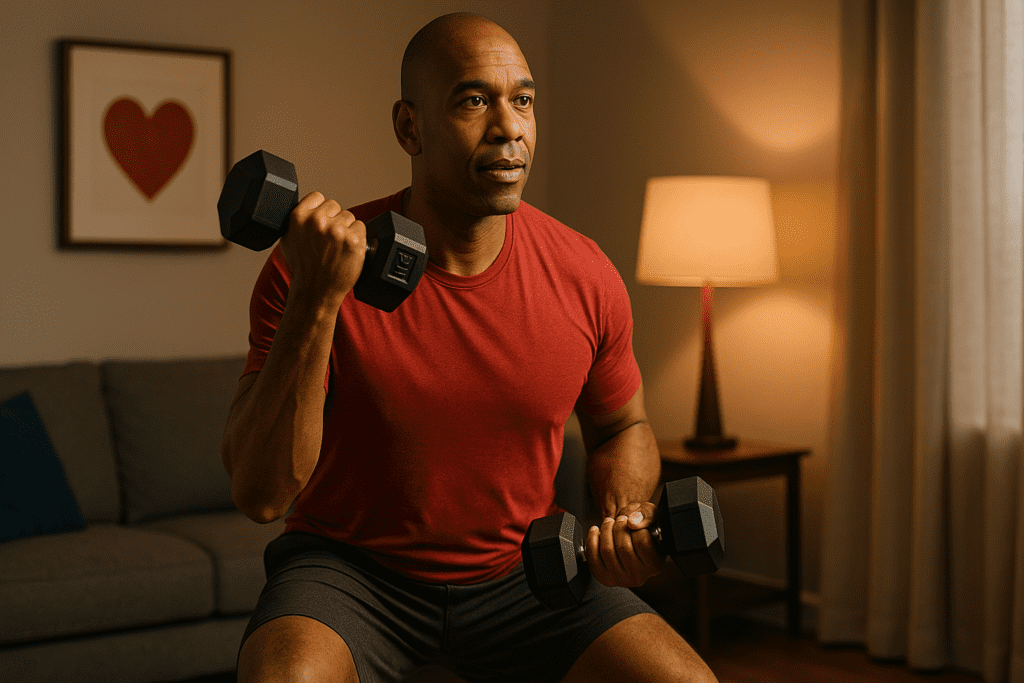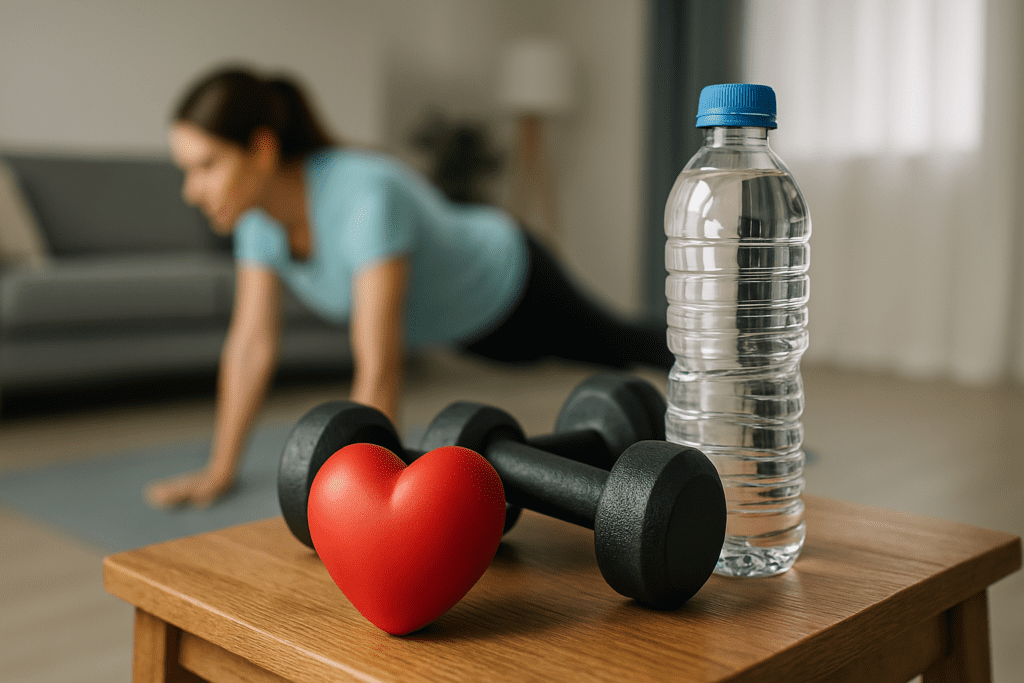In an era where chronic disease is increasingly linked to sedentary living, the importance of consistent, heart-healthy movement cannot be overstated. Cardiovascular disease remains the leading cause of death globally, and while diet and genetics certainly play a role, exercise is one of the most potent interventions available for prevention and management. Fortunately, supporting cardiovascular health doesn’t require an expensive gym membership or elaborate equipment. The right home gym routine, focused on full body workouts and weight training, can provide profound benefits not only for heart function but also for metabolic health, muscular endurance, and mental well-being.
You may also like: Top Cardiologist-Approved Cardio Workouts to Improve Cardiovascular Fitness and Heart Health Naturally
By integrating smart, scientifically grounded training principles into your daily or weekly schedule, it’s entirely possible to build an effective workout body plan from the comfort of your home. Whether you’re looking to strengthen your heart, lower your blood pressure, improve cholesterol, or simply live longer with more energy, adopting a structured approach to body exercise is one of the most accessible and rewarding steps you can take.
Let’s explore how home-based fitness can serve as a powerful ally for cardiovascular wellness, and how the best full body exercises, thoughtfully selected weight training workouts, and balanced programming can be harnessed for long-term heart health.
Why Cardiovascular Health Needs Strength and Full Body Movement
The traditional model of heart health has long been centered around aerobic activity—think brisk walking, cycling, or jogging. While these forms of exercise are undeniably beneficial, research now confirms that resistance training and full body workouts also contribute significantly to cardiovascular wellness. In fact, combining weight training with aerobic movement leads to more favorable outcomes than either alone.
When engaging in full body exercises, you activate multiple muscle groups simultaneously, leading to increased oxygen consumption, elevated heart rate, and improved circulation. These physiological responses stimulate cardiovascular adaptations such as enhanced vascular elasticity, reduced arterial stiffness, and improved cardiac output. Over time, this translates into a stronger heart muscle, better blood pressure control, and reduced risk of heart failure or stroke.
Strength training, especially when structured as a series of compound movements, serves a dual role. It not only builds lean muscle mass and enhances metabolic function but also demands coordination, core activation, and neuromuscular engagement—all of which increase cardiovascular demand when performed continuously or in circuits. When these routines are performed consistently within a home gym routine, they create an integrated stimulus that trains both the muscular and cardiovascular systems in harmony.
Building the Foundation: What a Heart-Healthy Home Gym Routine Should Include
Creating an effective home gym routine begins with understanding the elements that drive cardiovascular and muscular improvements. Unlike isolation exercises that target a single muscle, full body workouts require coordinated effort from multiple systems. The best full body exercises—such as squats, lunges, push-ups, and rows—engage the core, stimulate major muscle groups, and elevate the heart rate into the aerobic or even anaerobic zone depending on intensity.
A heart-smart routine should consist of a mix of resistance and aerobic elements. This might include bodyweight training circuits, resistance band workouts, or weight training workouts using dumbbells or kettlebells. Interval training formats such as high-intensity interval training (HIIT) or Tabata are particularly effective at improving VO2 max and reducing resting heart rate, both of which are indicators of improved cardiovascular capacity.
To maximize the cardiovascular benefits of a home workout body plan, consistency and progression are key. Start with lower intensity and shorter sessions if you’re new to exercise, then gradually increase duration, resistance, or repetition as your capacity improves. Including a variety of full body workouts also prevents plateaus and keeps the regimen engaging.

The Best Full Body Exercises for Cardiovascular and Muscular Benefits
When it comes to designing full body workouts, the quality of exercises matters more than quantity. Movements that engage large muscle groups—particularly those that involve both the upper and lower body—are most effective for improving heart health. Among the best full body exercises are squats, burpees, mountain climbers, and planks with shoulder taps. These movements combine strength, balance, and endurance in a way that elevates the heart rate and challenges the entire musculoskeletal system.
Take the squat, for instance. As a foundational body exercise, it works the quadriceps, hamstrings, glutes, and core while also increasing blood flow and promoting better joint mobility. When performed in a set with short rest intervals or in combination with upper body exercises like overhead presses, it becomes a powerful cardiovascular stimulus.
Burpees, while demanding, offer a full-body cardio challenge by combining a squat, push-up, and jump into one fluid motion. Similarly, mountain climbers integrate core stabilization with cardio movement, making them ideal for inclusion in a heart-healthy workout body routine. By selecting these types of compound movements and incorporating them into circuits or supersets, individuals can achieve a balance of strength and cardio that promotes vascular resilience and muscular development.
Weight Training Workouts and Their Role in Heart Health
While full body workouts often lean on bodyweight movements or dynamic circuits, traditional weight training workouts also play a crucial role in supporting cardiovascular wellness. Contrary to the myth that lifting weights is purely anaerobic and not heart-friendly, emerging evidence shows that resistance training—especially when performed with moderate to high volume—can significantly reduce cardiovascular disease risk.
Engaging in structured weight training workouts helps improve insulin sensitivity, reduce systemic inflammation, and lower triglyceride levels, all of which are closely linked to heart disease. Furthermore, by building lean muscle mass, strength training supports healthier metabolism and helps maintain optimal body weight, reducing strain on the heart over time.
A typical heart-healthy resistance workout might include movements like deadlifts, bench presses, bent-over rows, and lunges with weights. These compound lifts demand coordination, posture control, and energy, thereby stimulating a cardiovascular response even when performed at slower tempos. When structured as part of supersets or circuit routines, these weight training workouts provide the dual benefit of strength and heart conditioning.
In a home gym routine, these exercises can be easily performed using adjustable dumbbells, resistance bands, or kettlebells. Even using water jugs, resistance tubes, or sandbags can mimic gym-level resistance and yield measurable cardiovascular benefits. The key is maintaining proper form, controlling breathing, and progressing gradually to avoid overtraining.
Designing a Sustainable Home Gym Routine for Cardiovascular Support
A well-balanced home gym routine should address all elements of fitness: strength, endurance, mobility, and recovery. For cardiovascular wellness, it’s important to structure workouts in a way that includes both steady-state and interval components. For instance, alternating between bodyweight circuits on one day and resistance-based full body exercises the next allows different energy systems to recover while maintaining heart health benefits.
A sample routine might involve three days per week of full body workouts, two days of moderate-intensity cardio like brisk walking or dancing, and one or two days of active recovery such as yoga or stretching. Each session should begin with a dynamic warm-up to increase blood flow and end with a cooldown to aid in cardiovascular recovery.
Within this framework, progression matters. As cardiovascular and muscular capacity improve, intensity should be increased through more challenging movements, heavier resistance, shorter rest intervals, or higher training volumes. The flexibility of a home gym routine also allows for customization based on fitness level, time constraints, and personal preferences—making it more sustainable in the long term.
The psychological element should not be overlooked either. Exercise adherence improves when workouts are enjoyable, varied, and goal-oriented. Setting measurable milestones—such as completing a certain number of workouts per month or increasing reps—can help maintain motivation and long-term cardiovascular benefits.
Why Full Body Workouts Outperform Isolated Movements for Heart Health
Isolated movements, such as bicep curls or calf raises, have their place in aesthetics-focused training. However, when it comes to improving cardiovascular wellness, full body workouts hold a distinct advantage. By engaging multiple muscle groups simultaneously, these routines demand greater oxygen consumption and increase cardiac workload, promoting stronger vascular adaptations.
From a physiological standpoint, full body exercises also stimulate a larger hormonal response. Movements like squats, push-ups, and rows trigger the release of growth hormone and testosterone, which not only support muscle growth but also enhance fat metabolism—an important factor in reducing cardiovascular risk.
Moreover, performing compound exercises in rapid succession (as seen in circuit training) mimics the effect of aerobic conditioning while simultaneously building muscular strength. This hybrid approach challenges the cardiovascular system without the need for traditional cardio equipment. For individuals managing heart-related conditions under medical supervision, this offers a versatile and often safer alternative to high-impact cardio.
By alternating between upper and lower body exercises, incorporating rest strategically, and maintaining proper pacing, full body workouts can be tailored to meet the cardiovascular needs of a wide range of individuals, including those with prehypertension or borderline metabolic syndrome.
The Role of Recovery and Mobility in a Heart-Healthy Routine
One often overlooked aspect of a successful home gym routine is recovery. While exercise acts as a form of physiological stress that strengthens the body over time, inadequate recovery can lead to chronic inflammation, elevated resting heart rate, and decreased immune function—all of which are counterproductive to cardiovascular health.
Mobility work, stretching, and proper sleep are crucial in optimizing recovery. After engaging in intense full body workouts or weight training workouts, the heart rate remains elevated for some time as the body undergoes metabolic and muscular repair. This afterburn effect, known as excess post-exercise oxygen consumption (EPOC), contributes to caloric burn and improved cardiorespiratory fitness—but it also increases the body’s need for rest.
Incorporating yoga, foam rolling, or breathwork into a weekly routine can improve circulation, reduce stress hormones like cortisol, and enhance parasympathetic nervous system activity, which plays a key role in heart rate variability and long-term cardiovascular resilience.
Additionally, ensuring hydration, proper nutrient intake, and electrolyte balance supports both muscle repair and cardiovascular function. For example, potassium and magnesium—electrolytes found in leafy greens and legumes—are vital for normal heart rhythm and blood pressure regulation. When paired with the right body exercise strategies, this integrative approach completes the heart-health equation.
Practical Strategies to Stay Consistent with Home-Based Cardio Strength Training
Creating a strong workout body routine is only effective if it is maintained consistently. One of the main advantages of a home gym routine is accessibility, yet paradoxically, many people struggle to adhere to home workouts due to distractions, lack of structure, or limited space. The solution lies in planning, accountability, and adaptability.
Establishing a fixed schedule, even if it’s just 20 to 30 minutes per day, builds routine and reduces decision fatigue. Logging workouts in a fitness journal or using tracking apps can also enhance motivation by visualizing progress. Setting up a designated space—even a small corner of a room—for full body workouts signals psychological readiness and minimizes procrastination.
Variety is equally essential. By rotating between the best full body exercises and incorporating different formats such as circuits, intervals, or timed sets, you avoid mental fatigue and physical plateaus. Music, online workout videos, or virtual group classes can inject energy and community into a solo routine.
Lastly, linking your fitness practice with heart-health goals—such as lowering blood pressure, reducing cholesterol medication dependency, or enhancing stamina for everyday activities—provides a sense of purpose that can weather fluctuations in motivation. The goal isn’t perfection but consistency, with each session contributing to a stronger, healthier cardiovascular system.

FAQ: Heart-Healthy Fitness at Home — Full Body Workouts and Weight Training for Cardiovascular Wellness
1. Can full body workouts improve mental health along with cardiovascular wellness?
Absolutely. Full body workouts stimulate the release of endorphins, dopamine, and serotonin, all of which are associated with improved mood and reduced anxiety. Unlike isolated exercises, full body exercises often require mindful coordination, which promotes cognitive engagement and body awareness—benefits that extend beyond physical health. Many individuals find that a structured home gym routine also provides a sense of control and consistency, especially in unpredictable times, reducing feelings of helplessness or stress. Integrating weight training workouts into a workout body plan has been linked with improved self-esteem and resilience, which can serve as psychological buffers against depression. The dual impact on cardiovascular and emotional systems makes full body workouts a cornerstone of both physical and mental fitness.
2. How can I modify full body workouts for joint issues or arthritis?
If you’re managing joint limitations or early-stage arthritis, modifications are key to maintaining a safe and effective body exercise regimen. Instead of high-impact movements like jump squats or burpees, you can substitute low-impact alternatives such as wall sits or step-ups onto low platforms. Using resistance bands in weight training workouts allows for controlled tension without joint compression. Additionally, incorporating mobility drills and isometric holds into your home gym routine can maintain range of motion while limiting inflammation. Full body exercises like glute bridges, bird-dogs, and modified push-ups can still provide cardiovascular and muscular benefits without compromising joint integrity. Always consult with a physical therapist for personalized guidance when pain or joint instability is present.
3. What are some ways to track cardiovascular improvements from a home-based workout body routine?
Tracking progress in cardiovascular fitness from home doesn’t require sophisticated equipment. A simple way is to monitor your resting heart rate over time—lower resting heart rates often indicate improved cardiovascular efficiency. You can also track how quickly your heart rate returns to baseline after completing full body exercises, known as heart rate recovery, which is a strong predictor of heart health. Many smartwatches and fitness apps now include VO2 max estimations, offering insight into how effectively your body utilizes oxygen during exertion. Logging your performance across various weight training workouts—such as number of reps, sets, or resistance level—in your home gym routine can help you correlate strength gains with endurance capacity. Ultimately, increased stamina during daily tasks, reduced shortness of breath, and improved sleep quality are signs that your workout body strategy is paying off.
4. Are there specific full body exercises that help lower blood pressure more effectively?
Yes, some full body exercises have been found particularly effective in lowering blood pressure, especially when integrated into circuit training or performed at moderate intensity. Isometric exercises such as wall sits or planks help reduce systolic blood pressure by improving vascular resistance control. Combining dynamic movements like step-through lunges and rows into your full body workouts enhances circulation and stimulates nitric oxide release, promoting vessel dilation. For those following a home gym routine, alternating between weight training workouts and aerobic intervals has shown consistent results in reducing both systolic and diastolic pressure. Consistency and proper breathing techniques during each body exercise session are also critical to maximizing the blood pressure-lowering effects.
5. How can I stay motivated to maintain a home gym routine long term?
Staying consistent with a home gym routine hinges on creating a system that feels purposeful and enjoyable. One strategy is to build themed workout body sessions—such as “Cardio Mondays” or “Full Body Fridays”—to provide structure and variety. Incorporating challenges, such as improving time under tension in your best full body exercises or increasing your dumbbell weight over a set period, creates intrinsic motivation. Social accountability also plays a role; joining online fitness groups or sharing progress with a friend can keep you engaged. Finally, customizing your workout space with equipment, lighting, or music you enjoy makes each session feel like an experience rather than a chore, improving the odds that your full body workouts become a lifestyle rather than a phase.
6. Can full body workouts help regulate cholesterol levels and support metabolic health?
Yes, full body workouts are instrumental in regulating lipid profiles and improving metabolic function. Performing compound movements engages multiple muscle groups, which increases insulin sensitivity and helps mobilize fat stores for energy. Research shows that a combination of aerobic activity and resistance-based weight training workouts is most effective for lowering LDL (bad) cholesterol and raising HDL (good) cholesterol. When performed regularly as part of a home gym routine, these workouts can help normalize blood sugar, reduce waist circumference, and improve overall metabolic flexibility. Full body exercises like deadlifts, push-ups, and kettlebell swings stimulate large energy demands that continue burning calories long after the session ends—an essential factor in maintaining a heart-healthy weight.
7. What role does breathing play during full body workouts and weight training?
Breathing properly during exercise is more than a detail—it’s a physiological necessity that directly affects your heart and muscle performance. During full body exercises, rhythmic breathing ensures a steady oxygen supply to muscles, preventing early fatigue and promoting cardiovascular efficiency. In weight training workouts, breath control is essential for maintaining intra-abdominal pressure, which supports the spine and reduces the risk of injury. The “exhale on exertion” principle—breathing out during the hardest part of a movement—helps stabilize blood pressure and prevents unnecessary spikes. Incorporating mindful breathing into your home gym routine also enhances mental focus and reduces sympathetic nervous system overactivation, contributing to heart rate variability improvements over time. Proper breathing isn’t just a technique; it’s a skill that optimizes every body exercise you perform.
8. Are there advanced techniques to enhance the intensity of full body workouts without more equipment?
Yes, there are many ways to increase the challenge of your workout body routine without buying new equipment. One of the most effective methods is tempo manipulation—slowing down the eccentric (lowering) phase of full body exercises like squats or push-ups to increase time under tension. Another strategy is using unilateral movements, such as single-leg Romanian deadlifts or single-arm rows, which challenge stability and core strength. You can also experiment with density training, where you perform as many sets as possible within a time cap, thereby increasing cardiovascular demand. Including active recovery drills such as mobility flows between weight training workouts helps maintain intensity while supporting joint health. These enhancements keep your home gym routine dynamic and progressively challenging, which is crucial for continuous heart and muscular adaptations.
9. How do full body workouts benefit older adults specifically in terms of cardiovascular health?
For older adults, full body workouts offer a comprehensive approach to maintaining cardiovascular, muscular, and functional health. As we age, the risk of sarcopenia (age-related muscle loss) and arterial stiffening increases, both of which are mitigated by consistent full body exercises that stimulate circulation and strength. Resistance-based weight training workouts help preserve bone density and joint stability, reducing fall risk and supporting mobility. Moreover, including balance and core-intensive moves in a home gym routine—such as modified squats, chair dips, or resistance band rows—enhances proprioception and confidence in movement. The aerobic benefit of full body workouts also improves heart rate variability and supports better oxygen exchange in older adults, making these routines an excellent preventive tool for age-related cardiovascular decline.
10. What’s the best way to combine full body workouts with a heart-healthy diet for optimal results?
Combining full body workouts with a heart-healthy diet creates a synergistic effect that amplifies cardiovascular protection. After a workout body session, the body is primed to absorb nutrients, making post-exercise meals an ideal opportunity to include lean proteins, complex carbohydrates, and healthy fats. Foods rich in omega-3s, such as salmon or flaxseeds, can reduce inflammation triggered by intense weight training workouts. Additionally, nitrate-rich vegetables like beets or leafy greens can enhance blood flow and support performance in full body exercises. Hydration also plays a crucial role; drinking water or electrolyte-replenishing fluids ensures proper heart rhythm and supports endurance. Integrating nutrition planning into your home gym routine reinforces the recovery process and sustains the energy needed for consistent body exercise, maximizing both short-term performance and long-term heart health.

Conclusion: How Full Body Exercises and Weight Training Support Long-Term Heart Health
Embracing full body workouts and thoughtfully crafted weight training workouts within a home gym routine offers more than just aesthetic rewards—it provides a powerful, evidence-based pathway to improved cardiovascular function. These exercise modalities foster stronger hearts, more efficient circulation, and better metabolic control, all from the comfort and convenience of your own space.
By integrating the best full body exercises into a consistent workout body plan, individuals can significantly reduce their risk for heart disease, lower blood pressure, and increase both energy and lifespan. When supported by adequate recovery, strategic nutrition, and a commitment to progression, these home-based routines become more than just a form of movement—they become a daily act of heart care.
Whether you’re just beginning or fine-tuning an existing body exercise routine, the journey toward cardiovascular health doesn’t require expensive equipment or complex strategies. It starts with showing up, moving intentionally, and choosing exercises that work the entire body while supporting the most vital muscle of all: your heart. With consistency, variety, and attention to how your body feels, heart-healthy fitness at home becomes not just possible, but profoundly effective.
cardio workouts at home, strength training for heart health, low impact home workouts, cardiovascular fitness routines, resistance training benefits, metabolic health and exercise, bodyweight training at home, heart-healthy exercise habits, exercise for blood pressure control, home-based fitness plans, functional strength training, beginner home fitness routine, muscle endurance workouts, aerobic and strength training, at-home heart workouts, strength training for beginners, fitness routine for seniors, circulation-boosting workouts, total body strength training, daily exercise for heart health
Further Reading:
A 7-Day Workout Schedule To Meet Your Fitness Goals
7 Best Exercises For Cardiovascular Fitness
Become the Strongest Version of Yourself With These 5 Full-Body Workouts
Disclaimer
The information contained in this article is provided for general informational purposes only and is not intended to serve as medical, legal, or professional advice. While MedNewsPedia strives to present accurate, up-to-date, and reliable content, no warranty or guarantee, expressed or implied, is made regarding the completeness, accuracy, or adequacy of the information provided. Readers are strongly advised to seek the guidance of a qualified healthcare provider or other relevant professionals before acting on any information contained in this article. MedNewsPedia, its authors, editors, and contributors expressly disclaim any liability for any damages, losses, or consequences arising directly or indirectly from the use, interpretation, or reliance on any information presented herein. The views and opinions expressed in this article are those of the author(s) and do not necessarily reflect the official policies or positions of MedNewsPedia.


